Ethnicity & Identity: A Responsive Reading Assignment & Reflection
VerifiedAdded on 2023/06/04
|9
|2640
|143
Essay
AI Summary
This essay provides a responsive reading and analysis of two articles focusing on ethnicity and identity in New Zealand. The first article explores the experiences of Chinese immigrants over 140 years, highlighting challenges related to identity formation, discrimination, and integration. It examines the impact of historical policies and societal attitudes on the Chinese community. The second article discusses Pakeha ethnicity, exploring white privilege and its influence on ethnic relations within New Zealand society, also addressing issues of inequality and biculturalism. The essay reflects on both articles, drawing comparisons and highlighting the significance of socialization in overcoming racial discrimination and promoting development and notes that Desklib provides access to similar assignments and study tools for students.
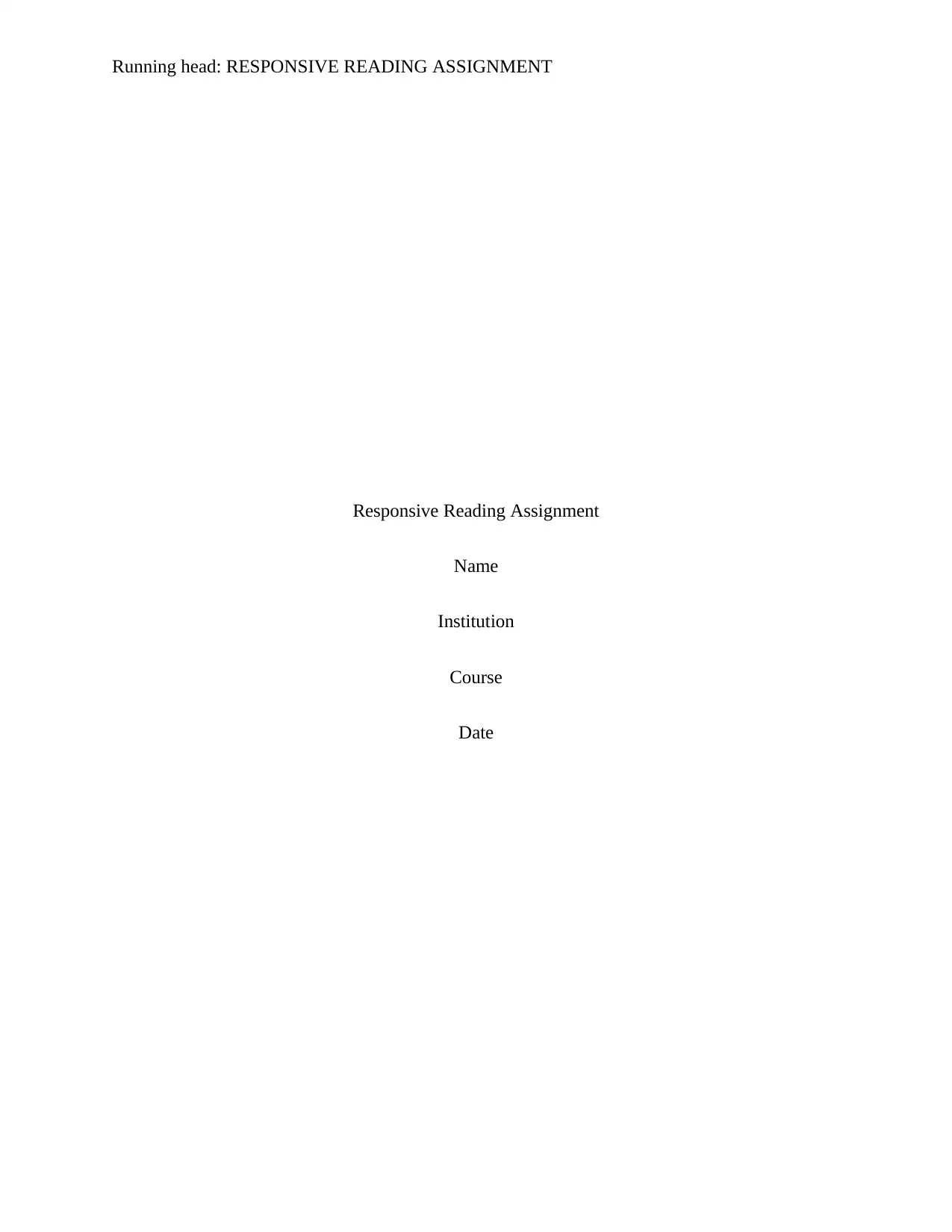
Running head: RESPONSIVE READING ASSIGNMENT
Responsive Reading Assignment
Name
Institution
Course
Date
Responsive Reading Assignment
Name
Institution
Course
Date
Paraphrase This Document
Need a fresh take? Get an instant paraphrase of this document with our AI Paraphraser
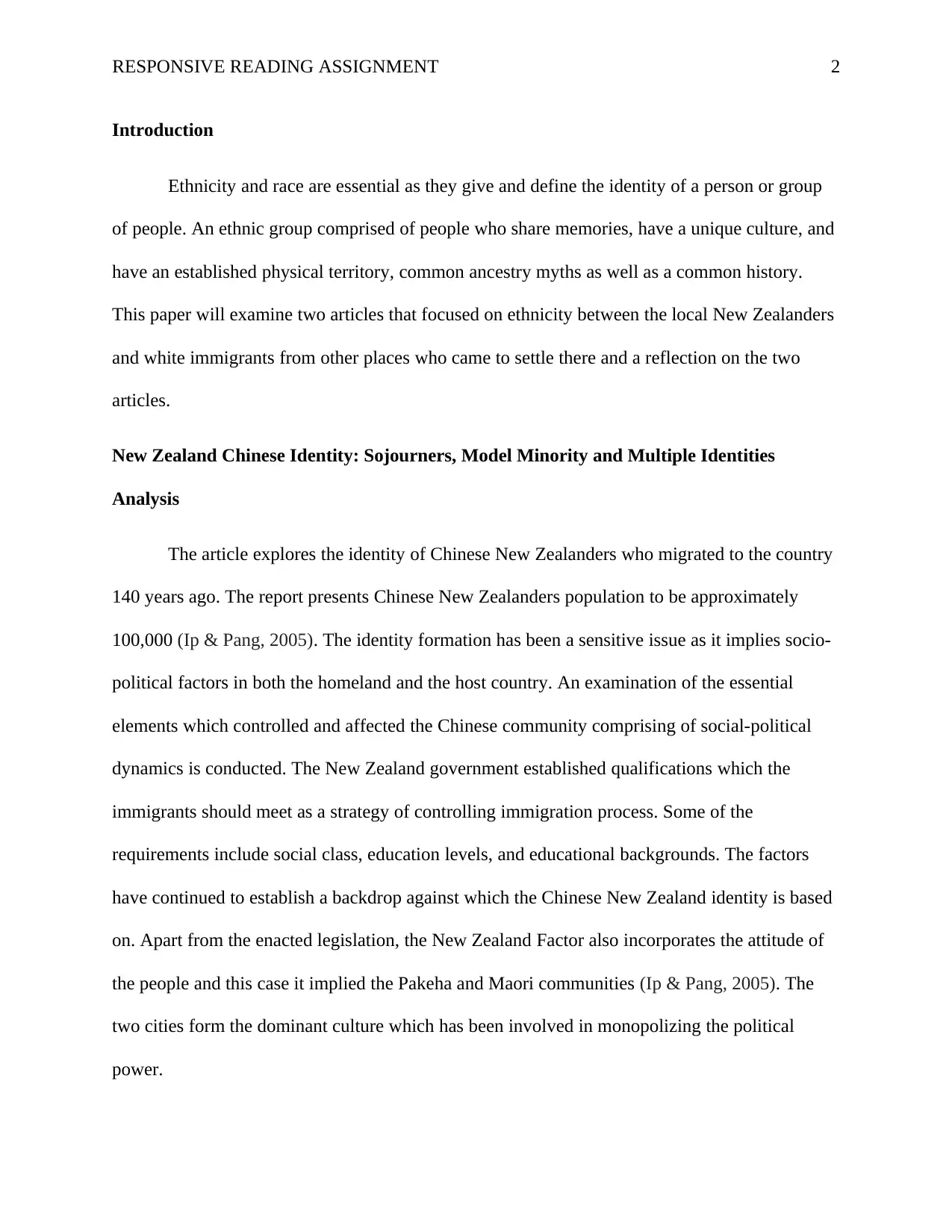
RESPONSIVE READING ASSIGNMENT 2
Introduction
Ethnicity and race are essential as they give and define the identity of a person or group
of people. An ethnic group comprised of people who share memories, have a unique culture, and
have an established physical territory, common ancestry myths as well as a common history.
This paper will examine two articles that focused on ethnicity between the local New Zealanders
and white immigrants from other places who came to settle there and a reflection on the two
articles.
New Zealand Chinese Identity: Sojourners, Model Minority and Multiple Identities
Analysis
The article explores the identity of Chinese New Zealanders who migrated to the country
140 years ago. The report presents Chinese New Zealanders population to be approximately
100,000 (Ip & Pang, 2005). The identity formation has been a sensitive issue as it implies socio-
political factors in both the homeland and the host country. An examination of the essential
elements which controlled and affected the Chinese community comprising of social-political
dynamics is conducted. The New Zealand government established qualifications which the
immigrants should meet as a strategy of controlling immigration process. Some of the
requirements include social class, education levels, and educational backgrounds. The factors
have continued to establish a backdrop against which the Chinese New Zealand identity is based
on. Apart from the enacted legislation, the New Zealand Factor also incorporates the attitude of
the people and this case it implied the Pakeha and Maori communities (Ip & Pang, 2005). The
two cities form the dominant culture which has been involved in monopolizing the political
power.
Introduction
Ethnicity and race are essential as they give and define the identity of a person or group
of people. An ethnic group comprised of people who share memories, have a unique culture, and
have an established physical territory, common ancestry myths as well as a common history.
This paper will examine two articles that focused on ethnicity between the local New Zealanders
and white immigrants from other places who came to settle there and a reflection on the two
articles.
New Zealand Chinese Identity: Sojourners, Model Minority and Multiple Identities
Analysis
The article explores the identity of Chinese New Zealanders who migrated to the country
140 years ago. The report presents Chinese New Zealanders population to be approximately
100,000 (Ip & Pang, 2005). The identity formation has been a sensitive issue as it implies socio-
political factors in both the homeland and the host country. An examination of the essential
elements which controlled and affected the Chinese community comprising of social-political
dynamics is conducted. The New Zealand government established qualifications which the
immigrants should meet as a strategy of controlling immigration process. Some of the
requirements include social class, education levels, and educational backgrounds. The factors
have continued to establish a backdrop against which the Chinese New Zealand identity is based
on. Apart from the enacted legislation, the New Zealand Factor also incorporates the attitude of
the people and this case it implied the Pakeha and Maori communities (Ip & Pang, 2005). The
two cities form the dominant culture which has been involved in monopolizing the political
power.
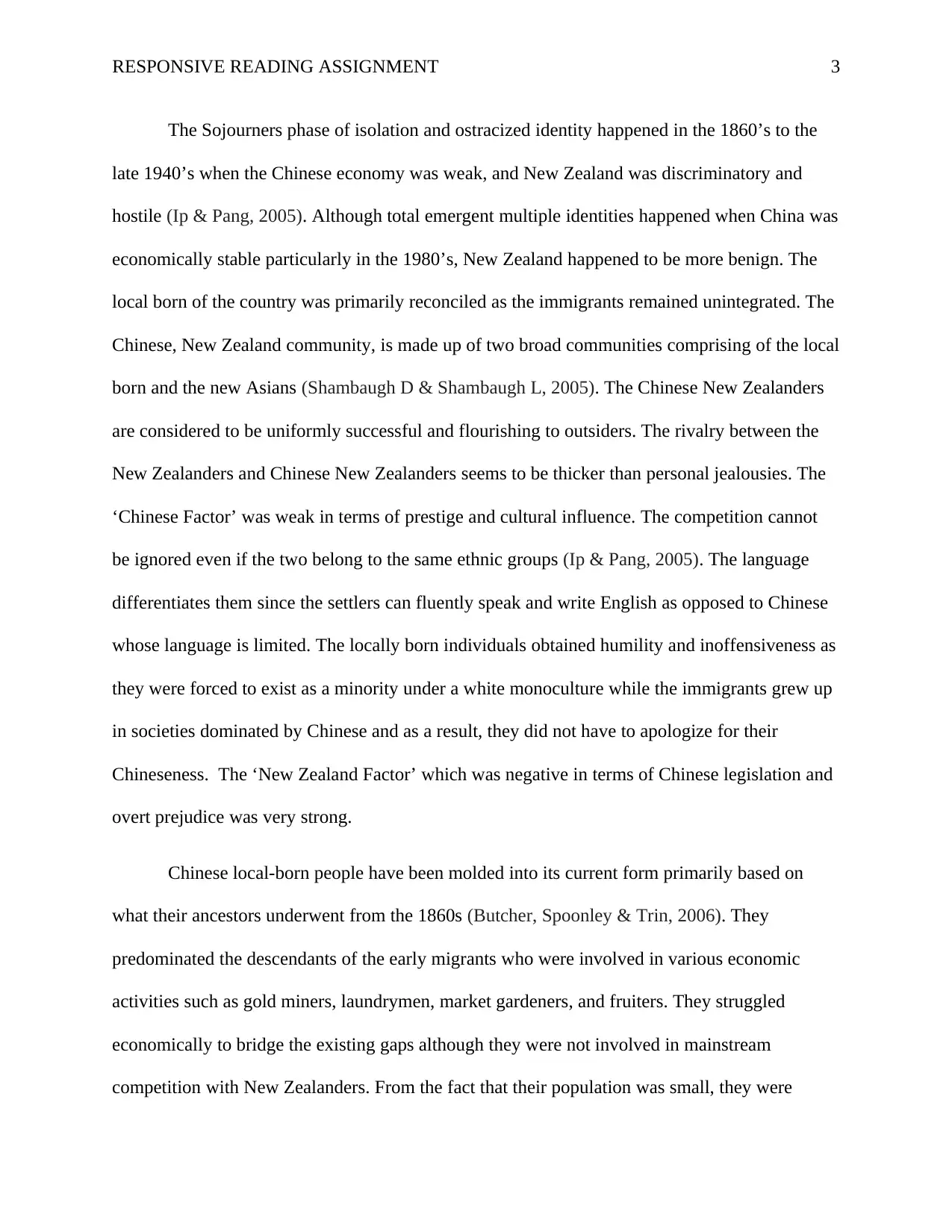
RESPONSIVE READING ASSIGNMENT 3
The Sojourners phase of isolation and ostracized identity happened in the 1860’s to the
late 1940’s when the Chinese economy was weak, and New Zealand was discriminatory and
hostile (Ip & Pang, 2005). Although total emergent multiple identities happened when China was
economically stable particularly in the 1980’s, New Zealand happened to be more benign. The
local born of the country was primarily reconciled as the immigrants remained unintegrated. The
Chinese, New Zealand community, is made up of two broad communities comprising of the local
born and the new Asians (Shambaugh D & Shambaugh L, 2005). The Chinese New Zealanders
are considered to be uniformly successful and flourishing to outsiders. The rivalry between the
New Zealanders and Chinese New Zealanders seems to be thicker than personal jealousies. The
‘Chinese Factor’ was weak in terms of prestige and cultural influence. The competition cannot
be ignored even if the two belong to the same ethnic groups (Ip & Pang, 2005). The language
differentiates them since the settlers can fluently speak and write English as opposed to Chinese
whose language is limited. The locally born individuals obtained humility and inoffensiveness as
they were forced to exist as a minority under a white monoculture while the immigrants grew up
in societies dominated by Chinese and as a result, they did not have to apologize for their
Chineseness. The ‘New Zealand Factor’ which was negative in terms of Chinese legislation and
overt prejudice was very strong.
Chinese local-born people have been molded into its current form primarily based on
what their ancestors underwent from the 1860s (Butcher, Spoonley & Trin, 2006). They
predominated the descendants of the early migrants who were involved in various economic
activities such as gold miners, laundrymen, market gardeners, and fruiters. They struggled
economically to bridge the existing gaps although they were not involved in mainstream
competition with New Zealanders. From the fact that their population was small, they were
The Sojourners phase of isolation and ostracized identity happened in the 1860’s to the
late 1940’s when the Chinese economy was weak, and New Zealand was discriminatory and
hostile (Ip & Pang, 2005). Although total emergent multiple identities happened when China was
economically stable particularly in the 1980’s, New Zealand happened to be more benign. The
local born of the country was primarily reconciled as the immigrants remained unintegrated. The
Chinese, New Zealand community, is made up of two broad communities comprising of the local
born and the new Asians (Shambaugh D & Shambaugh L, 2005). The Chinese New Zealanders
are considered to be uniformly successful and flourishing to outsiders. The rivalry between the
New Zealanders and Chinese New Zealanders seems to be thicker than personal jealousies. The
‘Chinese Factor’ was weak in terms of prestige and cultural influence. The competition cannot
be ignored even if the two belong to the same ethnic groups (Ip & Pang, 2005). The language
differentiates them since the settlers can fluently speak and write English as opposed to Chinese
whose language is limited. The locally born individuals obtained humility and inoffensiveness as
they were forced to exist as a minority under a white monoculture while the immigrants grew up
in societies dominated by Chinese and as a result, they did not have to apologize for their
Chineseness. The ‘New Zealand Factor’ which was negative in terms of Chinese legislation and
overt prejudice was very strong.
Chinese local-born people have been molded into its current form primarily based on
what their ancestors underwent from the 1860s (Butcher, Spoonley & Trin, 2006). They
predominated the descendants of the early migrants who were involved in various economic
activities such as gold miners, laundrymen, market gardeners, and fruiters. They struggled
economically to bridge the existing gaps although they were not involved in mainstream
competition with New Zealanders. From the fact that their population was small, they were
⊘ This is a preview!⊘
Do you want full access?
Subscribe today to unlock all pages.

Trusted by 1+ million students worldwide
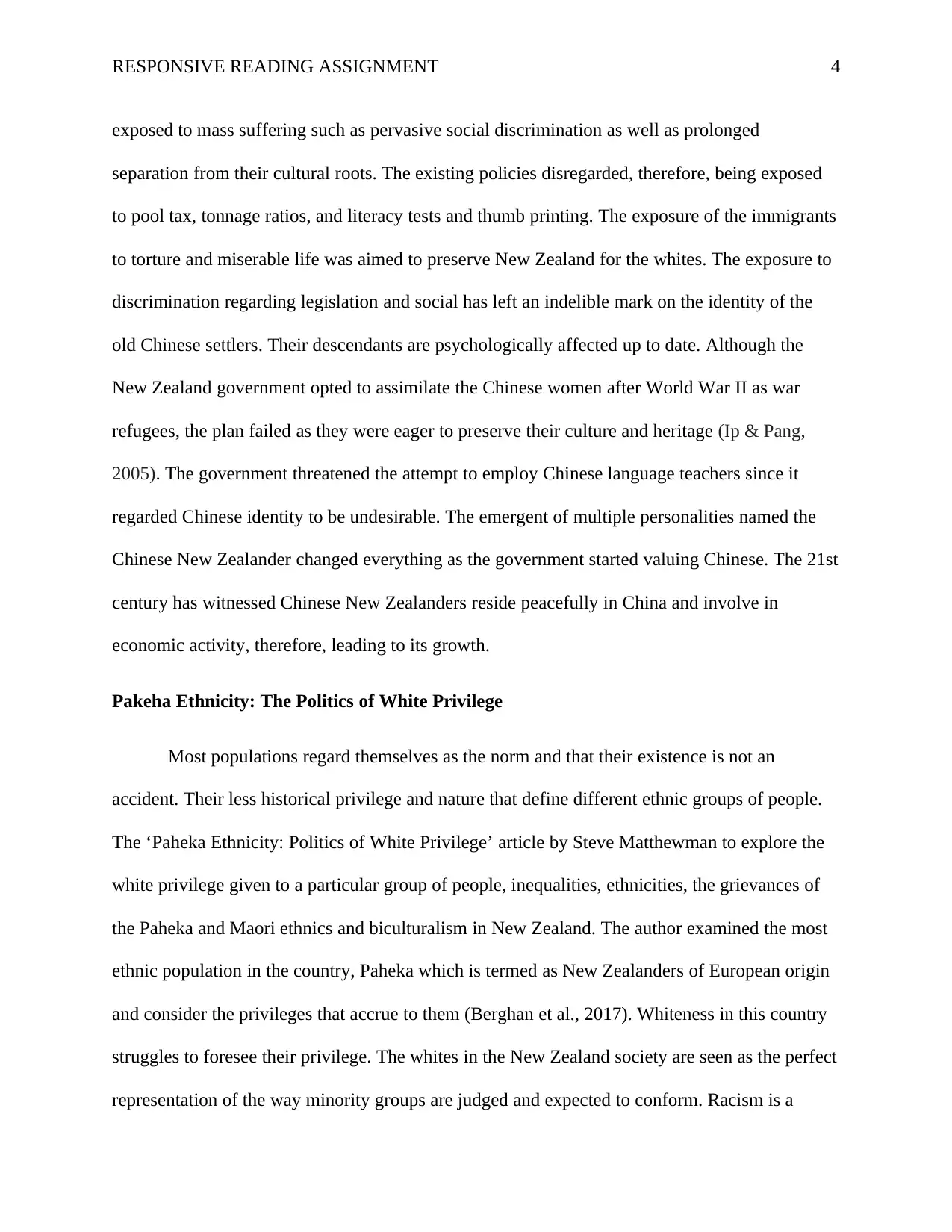
RESPONSIVE READING ASSIGNMENT 4
exposed to mass suffering such as pervasive social discrimination as well as prolonged
separation from their cultural roots. The existing policies disregarded, therefore, being exposed
to pool tax, tonnage ratios, and literacy tests and thumb printing. The exposure of the immigrants
to torture and miserable life was aimed to preserve New Zealand for the whites. The exposure to
discrimination regarding legislation and social has left an indelible mark on the identity of the
old Chinese settlers. Their descendants are psychologically affected up to date. Although the
New Zealand government opted to assimilate the Chinese women after World War II as war
refugees, the plan failed as they were eager to preserve their culture and heritage (Ip & Pang,
2005). The government threatened the attempt to employ Chinese language teachers since it
regarded Chinese identity to be undesirable. The emergent of multiple personalities named the
Chinese New Zealander changed everything as the government started valuing Chinese. The 21st
century has witnessed Chinese New Zealanders reside peacefully in China and involve in
economic activity, therefore, leading to its growth.
Pakeha Ethnicity: The Politics of White Privilege
Most populations regard themselves as the norm and that their existence is not an
accident. Their less historical privilege and nature that define different ethnic groups of people.
The ‘Paheka Ethnicity: Politics of White Privilege’ article by Steve Matthewman to explore the
white privilege given to a particular group of people, inequalities, ethnicities, the grievances of
the Paheka and Maori ethnics and biculturalism in New Zealand. The author examined the most
ethnic population in the country, Paheka which is termed as New Zealanders of European origin
and consider the privileges that accrue to them (Berghan et al., 2017). Whiteness in this country
struggles to foresee their privilege. The whites in the New Zealand society are seen as the perfect
representation of the way minority groups are judged and expected to conform. Racism is a
exposed to mass suffering such as pervasive social discrimination as well as prolonged
separation from their cultural roots. The existing policies disregarded, therefore, being exposed
to pool tax, tonnage ratios, and literacy tests and thumb printing. The exposure of the immigrants
to torture and miserable life was aimed to preserve New Zealand for the whites. The exposure to
discrimination regarding legislation and social has left an indelible mark on the identity of the
old Chinese settlers. Their descendants are psychologically affected up to date. Although the
New Zealand government opted to assimilate the Chinese women after World War II as war
refugees, the plan failed as they were eager to preserve their culture and heritage (Ip & Pang,
2005). The government threatened the attempt to employ Chinese language teachers since it
regarded Chinese identity to be undesirable. The emergent of multiple personalities named the
Chinese New Zealander changed everything as the government started valuing Chinese. The 21st
century has witnessed Chinese New Zealanders reside peacefully in China and involve in
economic activity, therefore, leading to its growth.
Pakeha Ethnicity: The Politics of White Privilege
Most populations regard themselves as the norm and that their existence is not an
accident. Their less historical privilege and nature that define different ethnic groups of people.
The ‘Paheka Ethnicity: Politics of White Privilege’ article by Steve Matthewman to explore the
white privilege given to a particular group of people, inequalities, ethnicities, the grievances of
the Paheka and Maori ethnics and biculturalism in New Zealand. The author examined the most
ethnic population in the country, Paheka which is termed as New Zealanders of European origin
and consider the privileges that accrue to them (Berghan et al., 2017). Whiteness in this country
struggles to foresee their privilege. The whites in the New Zealand society are seen as the perfect
representation of the way minority groups are judged and expected to conform. Racism is a
Paraphrase This Document
Need a fresh take? Get an instant paraphrase of this document with our AI Paraphraser
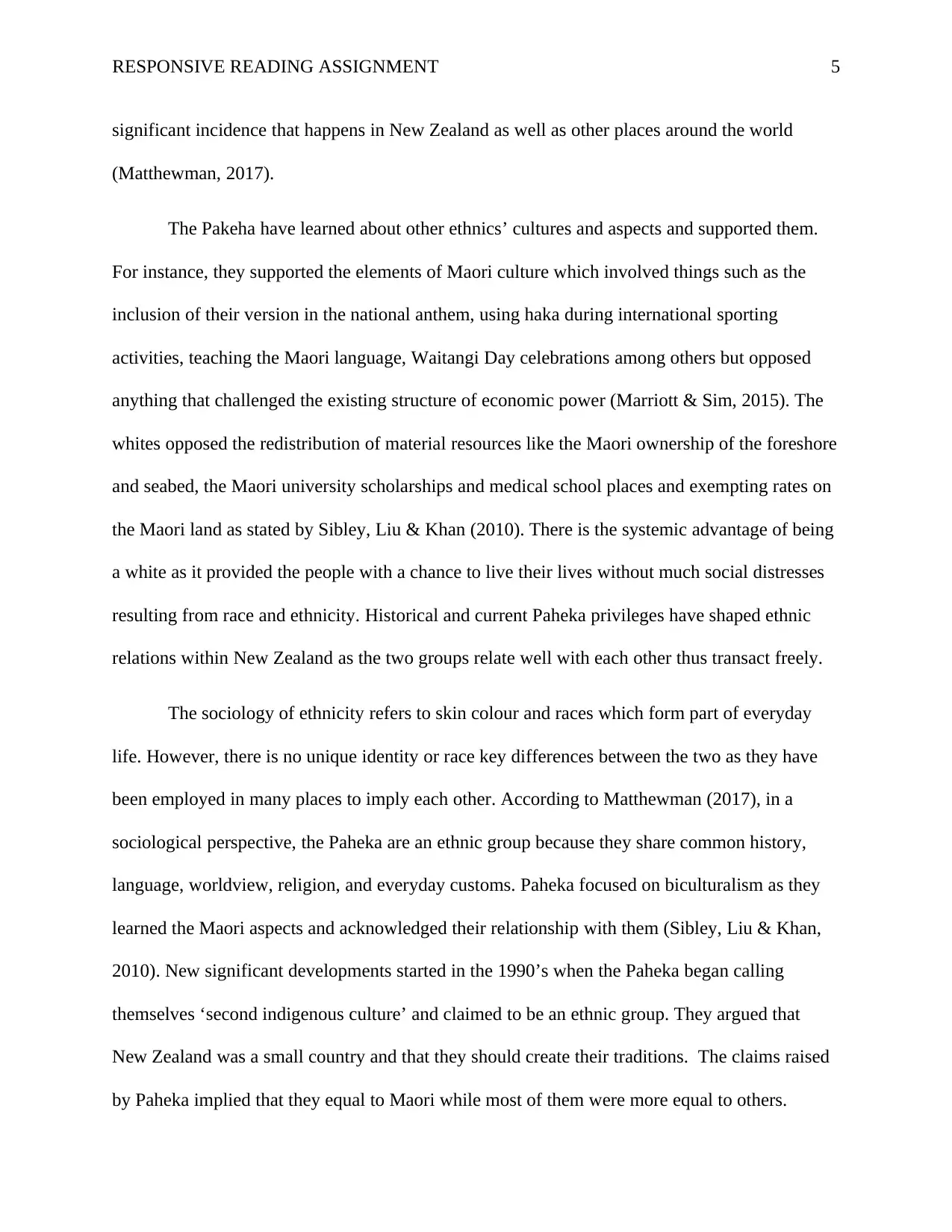
RESPONSIVE READING ASSIGNMENT 5
significant incidence that happens in New Zealand as well as other places around the world
(Matthewman, 2017).
The Pakeha have learned about other ethnics’ cultures and aspects and supported them.
For instance, they supported the elements of Maori culture which involved things such as the
inclusion of their version in the national anthem, using haka during international sporting
activities, teaching the Maori language, Waitangi Day celebrations among others but opposed
anything that challenged the existing structure of economic power (Marriott & Sim, 2015). The
whites opposed the redistribution of material resources like the Maori ownership of the foreshore
and seabed, the Maori university scholarships and medical school places and exempting rates on
the Maori land as stated by Sibley, Liu & Khan (2010). There is the systemic advantage of being
a white as it provided the people with a chance to live their lives without much social distresses
resulting from race and ethnicity. Historical and current Paheka privileges have shaped ethnic
relations within New Zealand as the two groups relate well with each other thus transact freely.
The sociology of ethnicity refers to skin colour and races which form part of everyday
life. However, there is no unique identity or race key differences between the two as they have
been employed in many places to imply each other. According to Matthewman (2017), in a
sociological perspective, the Paheka are an ethnic group because they share common history,
language, worldview, religion, and everyday customs. Paheka focused on biculturalism as they
learned the Maori aspects and acknowledged their relationship with them (Sibley, Liu & Khan,
2010). New significant developments started in the 1990’s when the Paheka began calling
themselves ‘second indigenous culture’ and claimed to be an ethnic group. They argued that
New Zealand was a small country and that they should create their traditions. The claims raised
by Paheka implied that they equal to Maori while most of them were more equal to others.
significant incidence that happens in New Zealand as well as other places around the world
(Matthewman, 2017).
The Pakeha have learned about other ethnics’ cultures and aspects and supported them.
For instance, they supported the elements of Maori culture which involved things such as the
inclusion of their version in the national anthem, using haka during international sporting
activities, teaching the Maori language, Waitangi Day celebrations among others but opposed
anything that challenged the existing structure of economic power (Marriott & Sim, 2015). The
whites opposed the redistribution of material resources like the Maori ownership of the foreshore
and seabed, the Maori university scholarships and medical school places and exempting rates on
the Maori land as stated by Sibley, Liu & Khan (2010). There is the systemic advantage of being
a white as it provided the people with a chance to live their lives without much social distresses
resulting from race and ethnicity. Historical and current Paheka privileges have shaped ethnic
relations within New Zealand as the two groups relate well with each other thus transact freely.
The sociology of ethnicity refers to skin colour and races which form part of everyday
life. However, there is no unique identity or race key differences between the two as they have
been employed in many places to imply each other. According to Matthewman (2017), in a
sociological perspective, the Paheka are an ethnic group because they share common history,
language, worldview, religion, and everyday customs. Paheka focused on biculturalism as they
learned the Maori aspects and acknowledged their relationship with them (Sibley, Liu & Khan,
2010). New significant developments started in the 1990’s when the Paheka began calling
themselves ‘second indigenous culture’ and claimed to be an ethnic group. They argued that
New Zealand was a small country and that they should create their traditions. The claims raised
by Paheka implied that they equal to Maori while most of them were more equal to others.
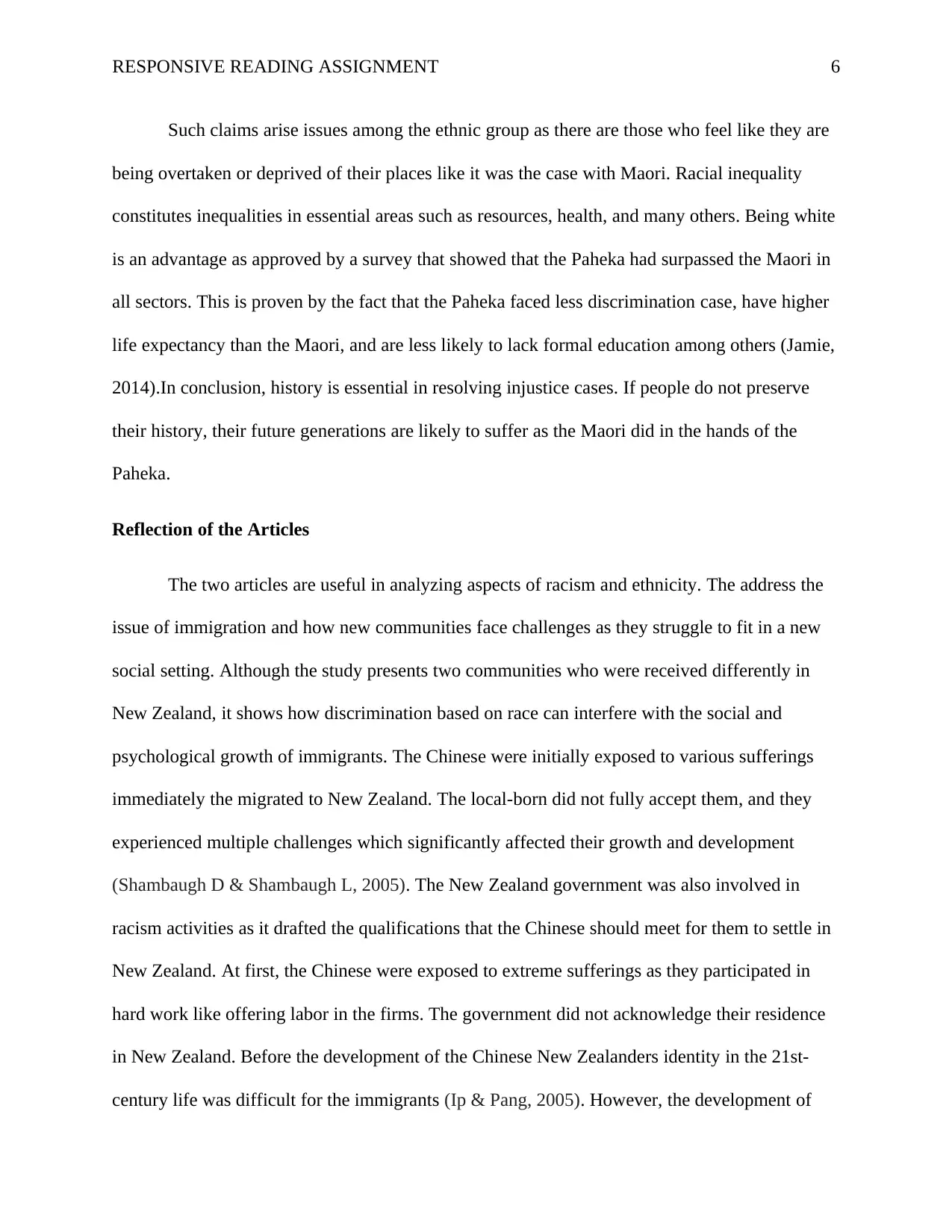
RESPONSIVE READING ASSIGNMENT 6
Such claims arise issues among the ethnic group as there are those who feel like they are
being overtaken or deprived of their places like it was the case with Maori. Racial inequality
constitutes inequalities in essential areas such as resources, health, and many others. Being white
is an advantage as approved by a survey that showed that the Paheka had surpassed the Maori in
all sectors. This is proven by the fact that the Paheka faced less discrimination case, have higher
life expectancy than the Maori, and are less likely to lack formal education among others (Jamie,
2014).In conclusion, history is essential in resolving injustice cases. If people do not preserve
their history, their future generations are likely to suffer as the Maori did in the hands of the
Paheka.
Reflection of the Articles
The two articles are useful in analyzing aspects of racism and ethnicity. The address the
issue of immigration and how new communities face challenges as they struggle to fit in a new
social setting. Although the study presents two communities who were received differently in
New Zealand, it shows how discrimination based on race can interfere with the social and
psychological growth of immigrants. The Chinese were initially exposed to various sufferings
immediately the migrated to New Zealand. The local-born did not fully accept them, and they
experienced multiple challenges which significantly affected their growth and development
(Shambaugh D & Shambaugh L, 2005). The New Zealand government was also involved in
racism activities as it drafted the qualifications that the Chinese should meet for them to settle in
New Zealand. At first, the Chinese were exposed to extreme sufferings as they participated in
hard work like offering labor in the firms. The government did not acknowledge their residence
in New Zealand. Before the development of the Chinese New Zealanders identity in the 21st-
century life was difficult for the immigrants (Ip & Pang, 2005). However, the development of
Such claims arise issues among the ethnic group as there are those who feel like they are
being overtaken or deprived of their places like it was the case with Maori. Racial inequality
constitutes inequalities in essential areas such as resources, health, and many others. Being white
is an advantage as approved by a survey that showed that the Paheka had surpassed the Maori in
all sectors. This is proven by the fact that the Paheka faced less discrimination case, have higher
life expectancy than the Maori, and are less likely to lack formal education among others (Jamie,
2014).In conclusion, history is essential in resolving injustice cases. If people do not preserve
their history, their future generations are likely to suffer as the Maori did in the hands of the
Paheka.
Reflection of the Articles
The two articles are useful in analyzing aspects of racism and ethnicity. The address the
issue of immigration and how new communities face challenges as they struggle to fit in a new
social setting. Although the study presents two communities who were received differently in
New Zealand, it shows how discrimination based on race can interfere with the social and
psychological growth of immigrants. The Chinese were initially exposed to various sufferings
immediately the migrated to New Zealand. The local-born did not fully accept them, and they
experienced multiple challenges which significantly affected their growth and development
(Shambaugh D & Shambaugh L, 2005). The New Zealand government was also involved in
racism activities as it drafted the qualifications that the Chinese should meet for them to settle in
New Zealand. At first, the Chinese were exposed to extreme sufferings as they participated in
hard work like offering labor in the firms. The government did not acknowledge their residence
in New Zealand. Before the development of the Chinese New Zealanders identity in the 21st-
century life was difficult for the immigrants (Ip & Pang, 2005). However, the development of
⊘ This is a preview!⊘
Do you want full access?
Subscribe today to unlock all pages.

Trusted by 1+ million students worldwide
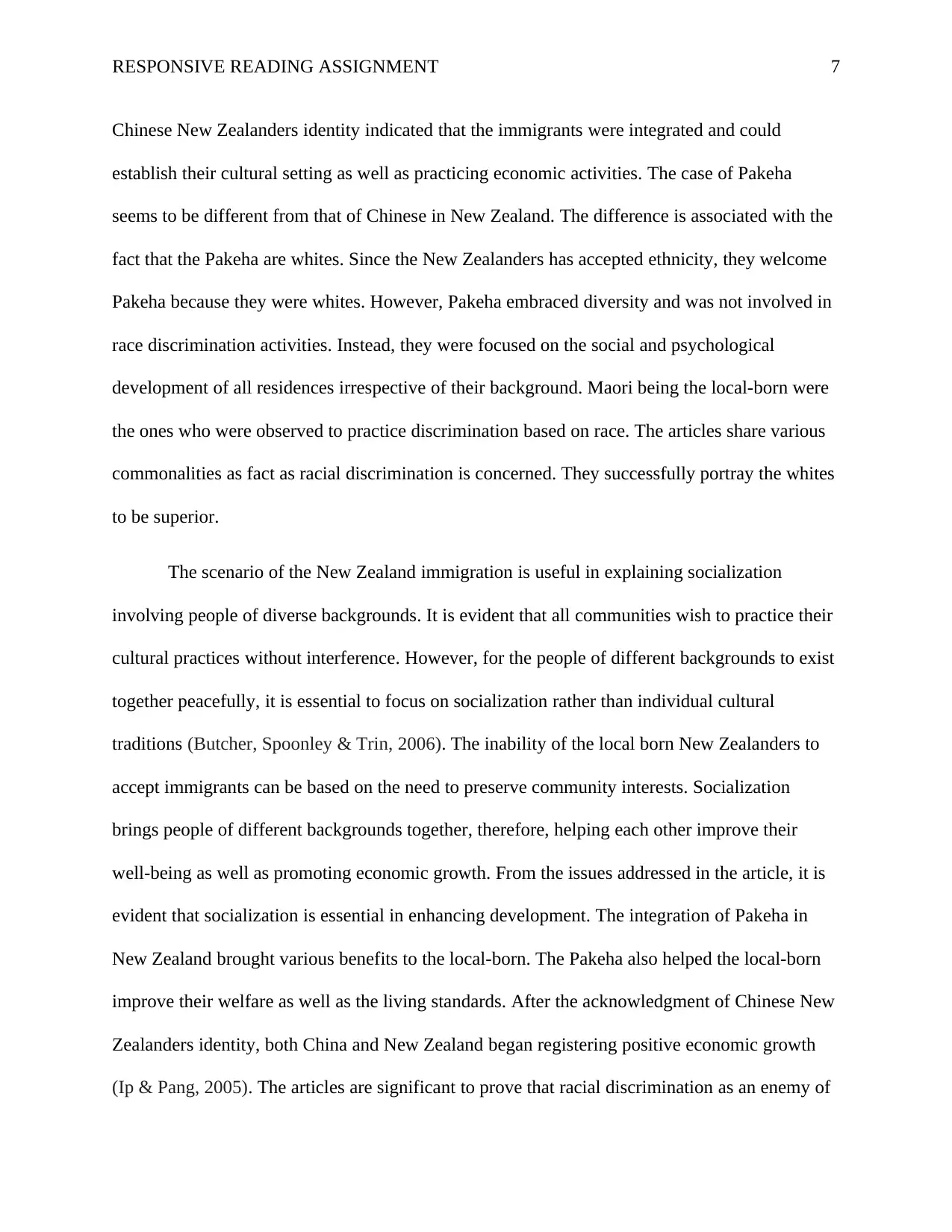
RESPONSIVE READING ASSIGNMENT 7
Chinese New Zealanders identity indicated that the immigrants were integrated and could
establish their cultural setting as well as practicing economic activities. The case of Pakeha
seems to be different from that of Chinese in New Zealand. The difference is associated with the
fact that the Pakeha are whites. Since the New Zealanders has accepted ethnicity, they welcome
Pakeha because they were whites. However, Pakeha embraced diversity and was not involved in
race discrimination activities. Instead, they were focused on the social and psychological
development of all residences irrespective of their background. Maori being the local-born were
the ones who were observed to practice discrimination based on race. The articles share various
commonalities as fact as racial discrimination is concerned. They successfully portray the whites
to be superior.
The scenario of the New Zealand immigration is useful in explaining socialization
involving people of diverse backgrounds. It is evident that all communities wish to practice their
cultural practices without interference. However, for the people of different backgrounds to exist
together peacefully, it is essential to focus on socialization rather than individual cultural
traditions (Butcher, Spoonley & Trin, 2006). The inability of the local born New Zealanders to
accept immigrants can be based on the need to preserve community interests. Socialization
brings people of different backgrounds together, therefore, helping each other improve their
well-being as well as promoting economic growth. From the issues addressed in the article, it is
evident that socialization is essential in enhancing development. The integration of Pakeha in
New Zealand brought various benefits to the local-born. The Pakeha also helped the local-born
improve their welfare as well as the living standards. After the acknowledgment of Chinese New
Zealanders identity, both China and New Zealand began registering positive economic growth
(Ip & Pang, 2005). The articles are significant to prove that racial discrimination as an enemy of
Chinese New Zealanders identity indicated that the immigrants were integrated and could
establish their cultural setting as well as practicing economic activities. The case of Pakeha
seems to be different from that of Chinese in New Zealand. The difference is associated with the
fact that the Pakeha are whites. Since the New Zealanders has accepted ethnicity, they welcome
Pakeha because they were whites. However, Pakeha embraced diversity and was not involved in
race discrimination activities. Instead, they were focused on the social and psychological
development of all residences irrespective of their background. Maori being the local-born were
the ones who were observed to practice discrimination based on race. The articles share various
commonalities as fact as racial discrimination is concerned. They successfully portray the whites
to be superior.
The scenario of the New Zealand immigration is useful in explaining socialization
involving people of diverse backgrounds. It is evident that all communities wish to practice their
cultural practices without interference. However, for the people of different backgrounds to exist
together peacefully, it is essential to focus on socialization rather than individual cultural
traditions (Butcher, Spoonley & Trin, 2006). The inability of the local born New Zealanders to
accept immigrants can be based on the need to preserve community interests. Socialization
brings people of different backgrounds together, therefore, helping each other improve their
well-being as well as promoting economic growth. From the issues addressed in the article, it is
evident that socialization is essential in enhancing development. The integration of Pakeha in
New Zealand brought various benefits to the local-born. The Pakeha also helped the local-born
improve their welfare as well as the living standards. After the acknowledgment of Chinese New
Zealanders identity, both China and New Zealand began registering positive economic growth
(Ip & Pang, 2005). The articles are significant to prove that racial discrimination as an enemy of
Paraphrase This Document
Need a fresh take? Get an instant paraphrase of this document with our AI Paraphraser
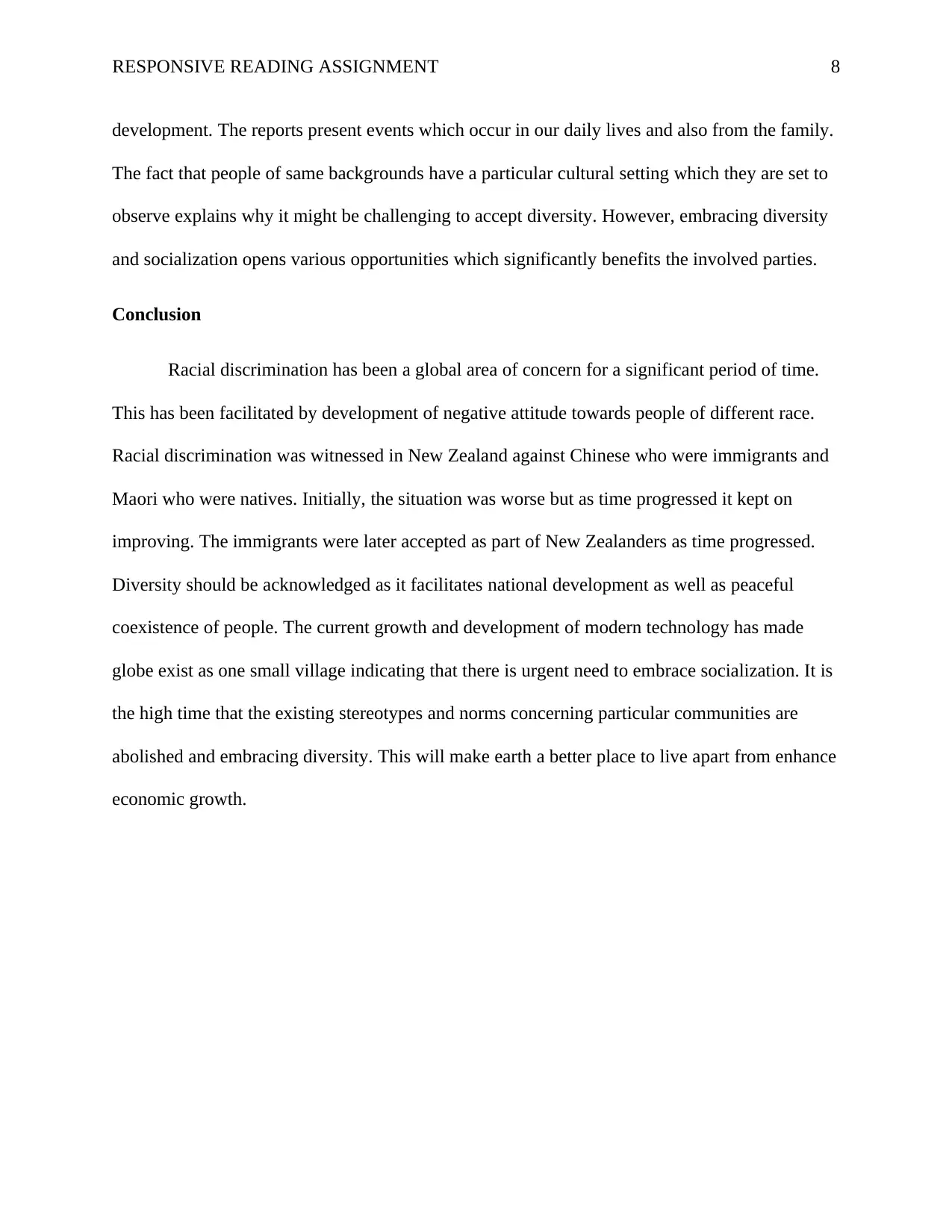
RESPONSIVE READING ASSIGNMENT 8
development. The reports present events which occur in our daily lives and also from the family.
The fact that people of same backgrounds have a particular cultural setting which they are set to
observe explains why it might be challenging to accept diversity. However, embracing diversity
and socialization opens various opportunities which significantly benefits the involved parties.
Conclusion
Racial discrimination has been a global area of concern for a significant period of time.
This has been facilitated by development of negative attitude towards people of different race.
Racial discrimination was witnessed in New Zealand against Chinese who were immigrants and
Maori who were natives. Initially, the situation was worse but as time progressed it kept on
improving. The immigrants were later accepted as part of New Zealanders as time progressed.
Diversity should be acknowledged as it facilitates national development as well as peaceful
coexistence of people. The current growth and development of modern technology has made
globe exist as one small village indicating that there is urgent need to embrace socialization. It is
the high time that the existing stereotypes and norms concerning particular communities are
abolished and embracing diversity. This will make earth a better place to live apart from enhance
economic growth.
development. The reports present events which occur in our daily lives and also from the family.
The fact that people of same backgrounds have a particular cultural setting which they are set to
observe explains why it might be challenging to accept diversity. However, embracing diversity
and socialization opens various opportunities which significantly benefits the involved parties.
Conclusion
Racial discrimination has been a global area of concern for a significant period of time.
This has been facilitated by development of negative attitude towards people of different race.
Racial discrimination was witnessed in New Zealand against Chinese who were immigrants and
Maori who were natives. Initially, the situation was worse but as time progressed it kept on
improving. The immigrants were later accepted as part of New Zealanders as time progressed.
Diversity should be acknowledged as it facilitates national development as well as peaceful
coexistence of people. The current growth and development of modern technology has made
globe exist as one small village indicating that there is urgent need to embrace socialization. It is
the high time that the existing stereotypes and norms concerning particular communities are
abolished and embracing diversity. This will make earth a better place to live apart from enhance
economic growth.
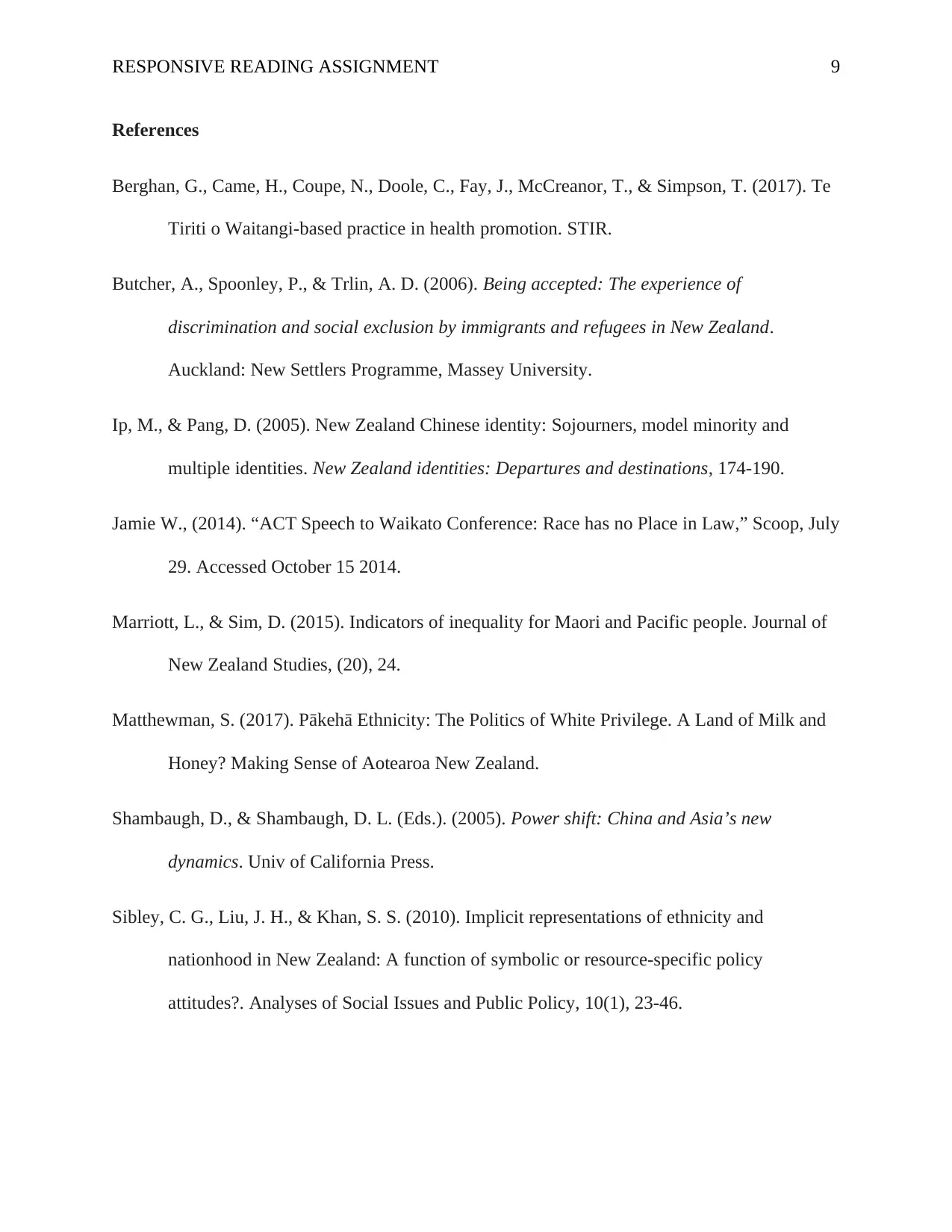
RESPONSIVE READING ASSIGNMENT 9
References
Berghan, G., Came, H., Coupe, N., Doole, C., Fay, J., McCreanor, T., & Simpson, T. (2017). Te
Tiriti o Waitangi-based practice in health promotion. STIR.
Butcher, A., Spoonley, P., & Trlin, A. D. (2006). Being accepted: The experience of
discrimination and social exclusion by immigrants and refugees in New Zealand.
Auckland: New Settlers Programme, Massey University.
Ip, M., & Pang, D. (2005). New Zealand Chinese identity: Sojourners, model minority and
multiple identities. New Zealand identities: Departures and destinations, 174-190.
Jamie W., (2014). “ACT Speech to Waikato Conference: Race has no Place in Law,” Scoop, July
29. Accessed October 15 2014.
Marriott, L., & Sim, D. (2015). Indicators of inequality for Maori and Pacific people. Journal of
New Zealand Studies, (20), 24.
Matthewman, S. (2017). Pākehā Ethnicity: The Politics of White Privilege. A Land of Milk and
Honey? Making Sense of Aotearoa New Zealand.
Shambaugh, D., & Shambaugh, D. L. (Eds.). (2005). Power shift: China and Asia’s new
dynamics. Univ of California Press.
Sibley, C. G., Liu, J. H., & Khan, S. S. (2010). Implicit representations of ethnicity and
nationhood in New Zealand: A function of symbolic or resource‐specific policy
attitudes?. Analyses of Social Issues and Public Policy, 10(1), 23-46.
References
Berghan, G., Came, H., Coupe, N., Doole, C., Fay, J., McCreanor, T., & Simpson, T. (2017). Te
Tiriti o Waitangi-based practice in health promotion. STIR.
Butcher, A., Spoonley, P., & Trlin, A. D. (2006). Being accepted: The experience of
discrimination and social exclusion by immigrants and refugees in New Zealand.
Auckland: New Settlers Programme, Massey University.
Ip, M., & Pang, D. (2005). New Zealand Chinese identity: Sojourners, model minority and
multiple identities. New Zealand identities: Departures and destinations, 174-190.
Jamie W., (2014). “ACT Speech to Waikato Conference: Race has no Place in Law,” Scoop, July
29. Accessed October 15 2014.
Marriott, L., & Sim, D. (2015). Indicators of inequality for Maori and Pacific people. Journal of
New Zealand Studies, (20), 24.
Matthewman, S. (2017). Pākehā Ethnicity: The Politics of White Privilege. A Land of Milk and
Honey? Making Sense of Aotearoa New Zealand.
Shambaugh, D., & Shambaugh, D. L. (Eds.). (2005). Power shift: China and Asia’s new
dynamics. Univ of California Press.
Sibley, C. G., Liu, J. H., & Khan, S. S. (2010). Implicit representations of ethnicity and
nationhood in New Zealand: A function of symbolic or resource‐specific policy
attitudes?. Analyses of Social Issues and Public Policy, 10(1), 23-46.
⊘ This is a preview!⊘
Do you want full access?
Subscribe today to unlock all pages.

Trusted by 1+ million students worldwide
1 out of 9
Your All-in-One AI-Powered Toolkit for Academic Success.
+13062052269
info@desklib.com
Available 24*7 on WhatsApp / Email
![[object Object]](/_next/static/media/star-bottom.7253800d.svg)
Unlock your academic potential
Copyright © 2020–2025 A2Z Services. All Rights Reserved. Developed and managed by ZUCOL.